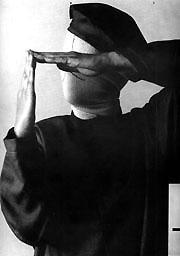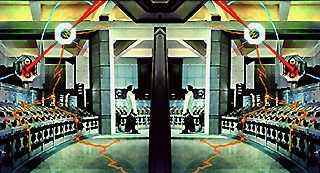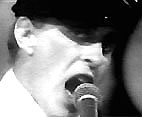the
works of Robert Calvert
-
part III: 1976 > '78 -
"I
work these peculiar hours between ten at night to five in the morning
(...)
the rest of the time I'm thinking about it. After I've finished, I get
into bed
and put a tape on and watch about three movies before I go to sleep.
This is the most bizarre thing - the birds are singing outside and there
are movies on TV." - R.C.
This list of Calvert's
works is broken up into six parts.
This part [ III ] includes the works from '76 to '78.
jump straight to
part I / II
/ IV /
V / VI
... roll down to
explore part III ...
![]()
![]()
|
|
|

However, the struggles that were lying ahead were probably inevitable. 3 of the 6 members were shown the door by Brock and Calvert - now sharing control of the band - and for good actually, as the next record became their true Meisterwerk. Read Calvert's comments on the story around his Steppenwolf lyrics - steming from Hesse's book. > More pics and infos on ASTOUNDING SOUNDS... > More on the artwork for ASTOUNDING - by Tony Hyde and Barney Bubbles - one of Britain's most influential designers. TRACKS: Reefer Madness / Steppenwolf (illustrated - plus sound) / City of Lagoons / The Aubergine that ate Rangoon / Kerb Crawler / Kadu Flyer / Chronoglide Skyway / - the new CD-release by Griffin features also: Back on the Streets / Honky Dorky / The Dream of Isis
The story takes place in an airplane over the drop zone of a military training area. It is based on a significant incidence in Jimi Hendrix“ life during his military service: Hendrix enlisted at age 17 in the US Airborne Paratroopers. He made 25 jumps and was inmidst his training when suddenly becoming afraid of his next jump... - refusing to step outside, because an inner-voice told him so... His antagonist in this play, Sergeant McNulty, 100% red-neck-military-machine, tries to persuade Private James Marshall Hendrix out of the plane and into the sky. Alone together on this exercise flight, private and sergeant fight their own war over their opposing American dreams. On his last jump Jimi broke his ankle and injured his back. He was released from the Army only to make the much greater jump into the rock-music arena, entrancing the psychedelic and various other generations to come - before his final leap into the musician's pantheon. > Read some illustrated reviews of the performances in '76 and '85. 'THE STAR...' wasn't the only time that Jimi Hendrix incinerated Calvert's imagination: Cattle at Twilight is a short prose-text he wrote on Hendrix and Noël Coward...watching some of us from up there... > Voodoo Child (animated. poem & sound files - a lot of very wothwhile data...) - Calvert's ode to Hendrix; from Centigrade 232 - incl. a soundfile of Calvert's live-cover version of Purple Haze. > NEWS; 18. Aug. 2005  The
Pentameters Theatre, London presents: The
Pentameters Theatre, London presents:"The Stars That Play With Laughing Sam’s Dice" by Robert Calvert Pentameters presents the first production in 20 years of this fascinating play, about a little-known and formative episode in the early life of Jimi Hendrix, and the first production of the play since the death of the author in 1988. The play was written in 1975/76 and was first produced by Leonie Scott-Matthews at Pentametres Theatre in 1976. More infos HERE > NEW: read a collection of reviews of the 2005-staging of The Stars... > NEWS - Sept. 2008 The Pentameters Theatre in London did it once again... as part of the theatre's 40th anniversary and in memory of Calvert, who died 20 years ago, the Pentameters team produced yet another staging of "The Stars..." - and not only that... they made it into a wonderful double-bill, as they also premiered Calvert's short dialogue piece Cattle at Twilight. Hat's off to Pentameters and especially to Léonie Scott-Matthews who directed and produced these shows.

Calvert`s subjects range from new technologies / post-nuclear wastelands / the threat of Islamic fundamentalism / an ambiguous review of the lost and commercialised "Days of the Underground" to the subtle ironies of "Quark, Strangeness and Charm". With this record the band finally received the long overdue critical acclaim they deserved. Melody Maker even chose "Quark...." as the single of the month - and the band eventually appeard in Marc Bolan's TV show to play that track. Other classics are the oriental-style sabre-dance 'Hassan I Sahba' and the hypnotic 'Spirit of the Age' - for which lyrics Calvert made use of two of his best poems: The Clone's Poem and The Starfarer's Dispatch. I know that they are a bore, these "must have" recommendations - but this REALLY is one! > Find Calvert's comments on the album on the QUOTES pages. > And yet more infos on QUARK... > READ a review of QUARK from the NME, July 1977. TRACKS: Spirit of the Age / Damnation Alley / Fable of a Failed Race / Quark, Strangeness and Charm (illustrated - plus sound) / Hassan I Sahba / Forge of Vulcan (instrumental) / Days of the Underground / Iron Dream (instrumental) > NEWS: July 2004: HAWKWIND - the unstoppable pioneers of space/sci-fi rock - are shortly releasing their new album TAKE ME TO YOUR LEADER - it will also contain a new version of the classic QUARK-track Spirit of the Age - feat. Matthew Wright as guest vocalist. The new version of SPIRIT OF THE AGE will also be released as a single - and on top of it the band has produced a video to accompany it's release. More infos on it's production can be found HERE.

"There aren't any science-fiction poems in the book, oddly enough. I've written several but they were pruned out when I was finishing the collection. For years I've wanted to put out a definitive collection of poems and therefore one had to be extremely ruthless with the final choice." (from an interview in 1977) In a unique manner Calvert combines scientific / futuristic themes with his private views and obsessions on a highly emotional level - interspersed with his ironic and sarcastic overtones. Creating intense imageries and lucid, sometimes frightening visions of the human formulae, in the future. However not all the poems are focusing on scientific subjects. One of the many outstanding pieces is the legend of ezra pound - a marvellous combination of poetical tension, biting wit and surreal imagery that culminates in the evocation of Pound's traumatic experience when he got imprisoned by the American troops in Italy - 'for offences against the air', as Calvert put it - ending his life wandering through the corridors of his daughter's castle and "...firing at the echoes of the past with his guns of silence." -- just one short example of Calvert's talent for crafting astonishing word-imagery. Another example of his wide range of themes is the poem Fly on the Screen, which, in describing a seemingly trivial, day-to-day incident while watching at the omnipresent set. Calvert proofs his unique talent to combine (media-)critical and analytical views (which were again quite ahead of his time) with his poetical talent - while describing a phenomenon (and it's far-reaching consequences) that a number of post-modern philosphers wrote stacks of books about... - all packed into just 4 verses. The book is out of print today, as all of Calvert's writings - which is a definite SHAME - but hopefully, this will change soon. In 1986 Calvert read CENTIGRADE 232 on tape and released it on his private mail order service named Harbour publications. Though all of the poems are recited in quite a calm and almost restraind manner, these performances bear a brooding intensity - often mixed with superb humorous (I'd say 'Calvertian') undertones. A good example for this is his hilarious piece on Winston Churchill as a rock star: "There's one called "Churchill's Secret Rock Deal" - which was actually a headline dealing with one of th younger Churchills, not Winston, working out some deal with Franco over the Rock of Gibraltar. It was such a beautiful idea it made me think of a poem about Winston setting up a record contract." > NEW: a memory-report of the Centigrade 232 book-launch-event - read all about the strange incidents way back in 1977. (and in case you think that the cover of the book is quite misleading in terms of it's content, you are actually quite right - however, it wasn't in terms of the book-launch...) > You'll find a broad selection from the 'Centigrade 232' poems on the WORDS pages. > Several poems are presented on separate, illustrated pages, including soundfiles of Calvert reading them. Find the whole collection at Calv-Art. > Switch to some comments of Calvert on the story of Ezra Pound and a planned stageplay project on him. [HERE you'll find Calvert's outstanding poem on Pound] > In 1975 Calvert won the Capital Radio Poetry Award with one of the poems feat. in CENTIGRADE 232: CIRCLE LINE - HERE you'll find a transcription of the live-phone-call, when the Capital Radio's DJ delivered the good news to the poet himself...

Unfortunately after the next tour this collaboration of Calvert and Hawkwind ended. Dave Brock and Bob Calvert certainly brought the best out of each other during those much too short 4 years. None of them ever reached that musical strength again for such a long period. > NEW: An extensive, illustrated feature on the concept behind the 1978 Hawklords tour for which Calvert invented a brillant piece of a visionary concept: PAN TRANSCENDENTAL INDUSTRIES - "Reality You Can Rely On". > More infos on the HAWKLORDS album. > Read an extensive article / interview with Calvert and Mike Moorcock from that period / Nov. 1978. > See some exclusive photos from the Hawklords gig at Leicester de Montford Hall, 1978 TRACKS: Psi Power (illustrated + sound) / Free Fall / Automotion / 25 Years On / Flying Doctor / The Only Ones / (Only) The Dead Dreams of a Cold War Kid / The Age of the Micro Man |
If you know of any other works that don't appear on the following page/s,
please get in touch.
![]()
![]()
|
|||||||||||||||||||||||

...bug me...






 1978 -
1978 - 
